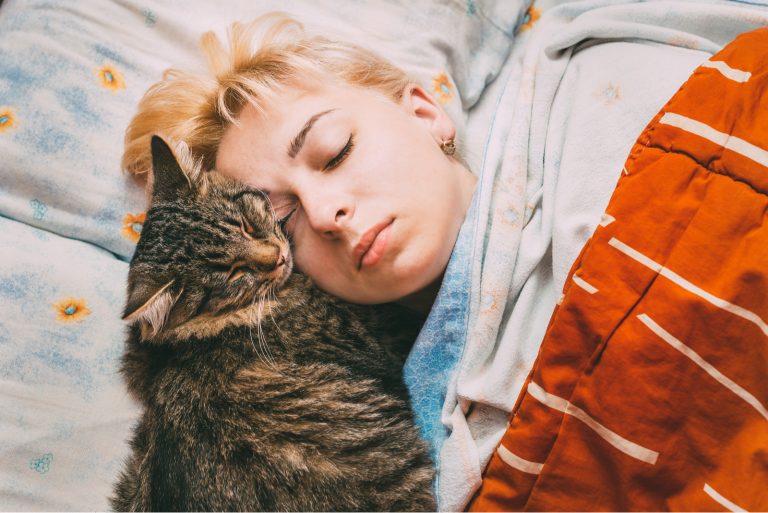Similarities And Differences Between Birman Vs Ragdoll Cats

At first glance, it can be hard to say whether a cat is a Birman or a Ragdoll. They are so similar in physical appearance, that it’s a little bit tricky to say which breed a cat belongs to. Even when we compare their personalities, they have many shared traits.
You might be wondering: How do you differentiate Birman Vs Ragdoll?
The main difference between a Birman and a Ragdoll is that Ragdolls are more laid back and need lots of attention, while Birmans are more active and less clingy. When it comes to their physical appearance, Ragdolls are bigger and usually have a white inverted V mark on their face.
They share a surprising number of other traits, such as the same eye colors, coat colors, friendliness, life span, and many other characteristics.
Continue reading to find out more about the similarities and differences between these two beautiful cat breeds!
Birman Vs Ragdoll
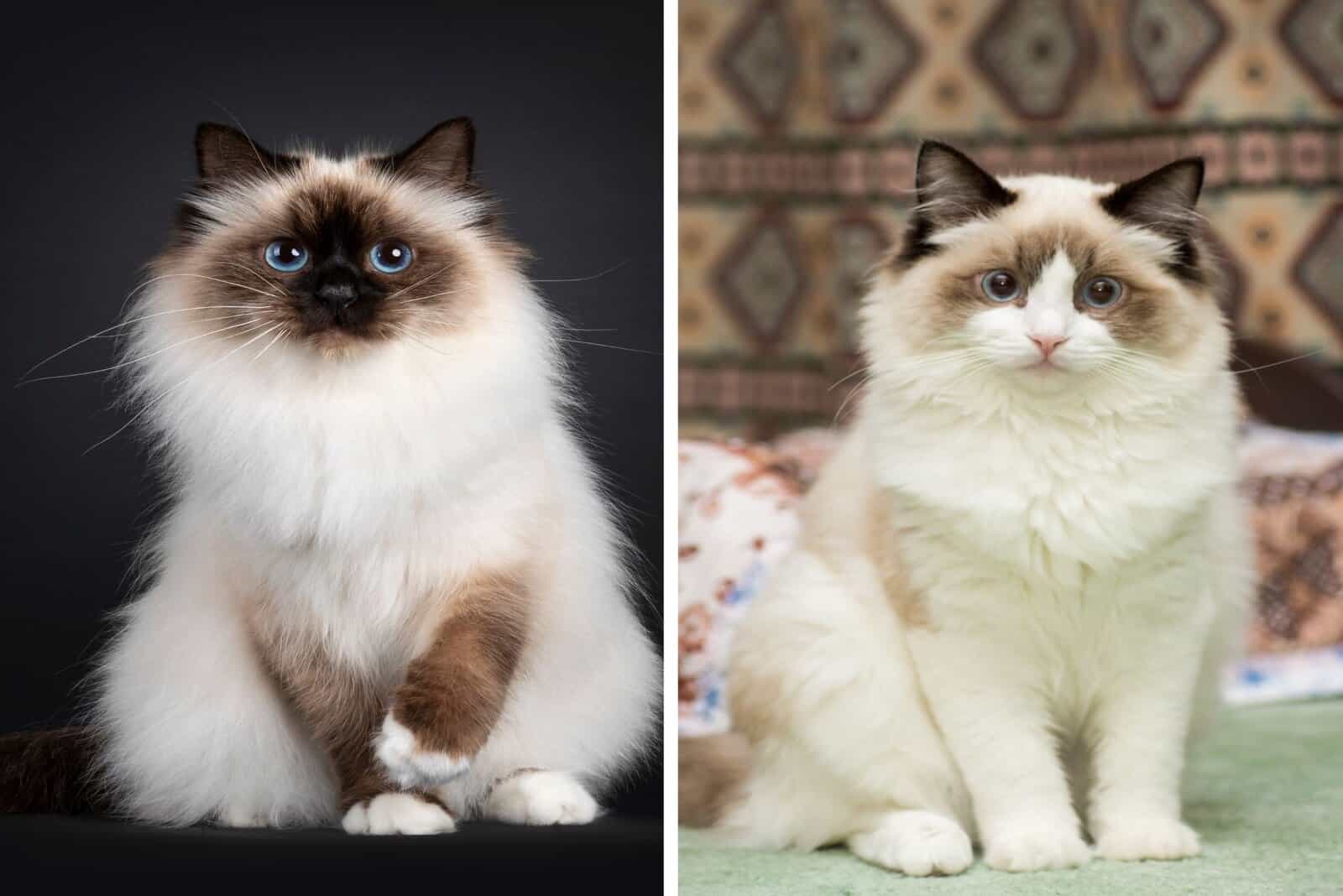
Even though they share some physical attributes and personality traits, that doesn’t mean they’re completely indistinguishable.
Once you learn a few key differences, you should be able to reliably differentiate between the two. The key differences are the size, color of the face (and sometimes paws), level of energy, and the need for attention.
Let’s get into more detail!
Considering there are many traits to be compared, let me divide them in 3 groups:
🐾 Physical appearance, such as size, coat color, eye color, etc.
🐾 Personality, such as how playful or how lazy the cat is
🐾 General information, such as ancestry, diet, lifespan, etc.
Let’s get down to business now!
Physical Appearance: Similarities & Differences
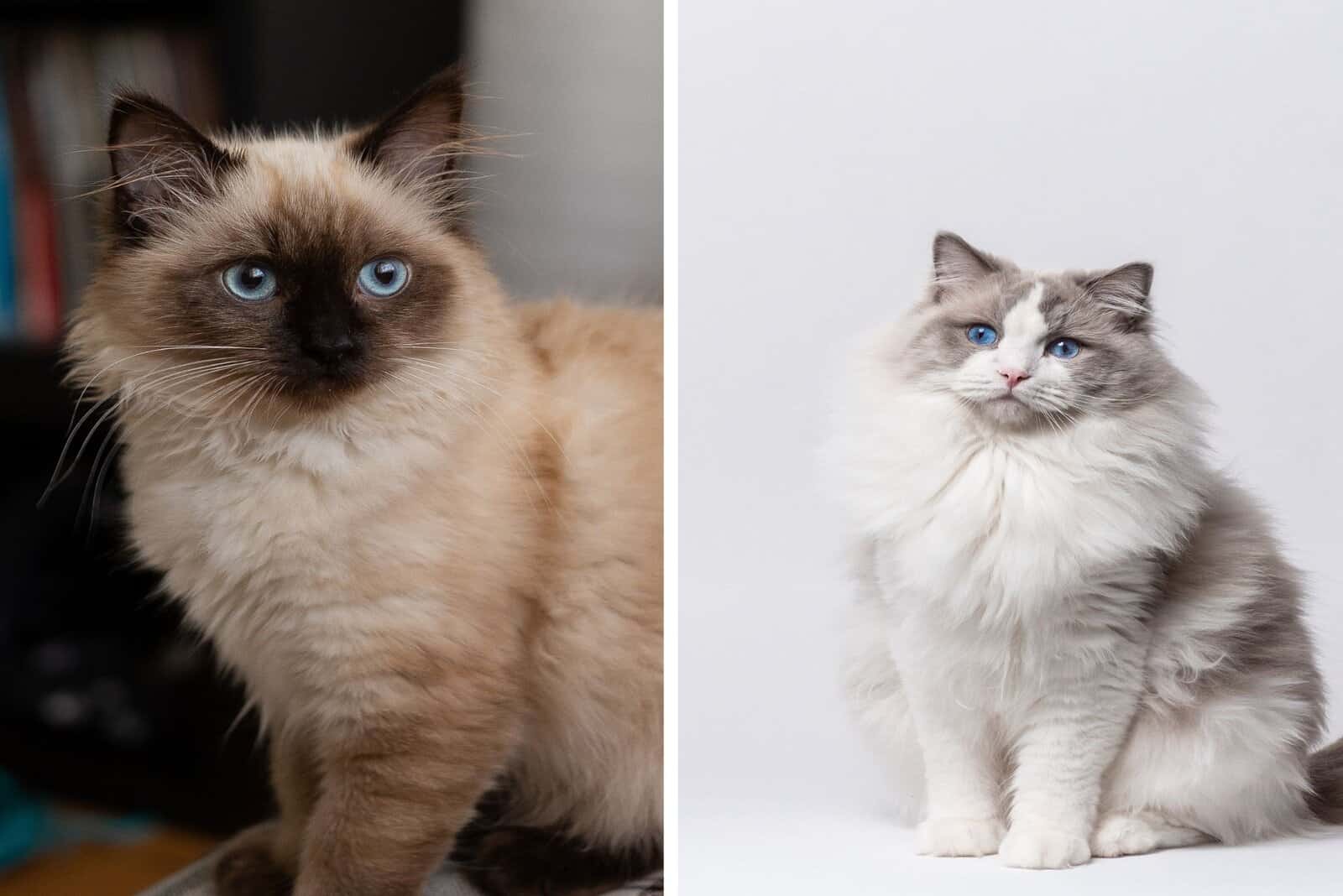
1. Size
As you might already know, both cat breeds are pretty big. The Ragdoll is larger than the Birman, but both of them are on the “Big Cat Breed” list for sure. The Ragdoll is one of the biggest domestic cat breeds, together with the Maine Coon and the Norwegian forest cat. Having long bodies and strong bones is a characteristic both the Birman and the Ragdoll share.
Birman
| Male | Female | |
|---|---|---|
| Weight | 10-12 lbs | 6-10 lbs |
| Height | 8-10 inches | 8-10 inches |
Ragdoll
| Male | Female | |
|---|---|---|
| Weight | 12-20 lbs | 8-15 lbs |
| Height | 9-11 inches | 9-11 inches |
2. Type Of Fur
Both Birman and Ragdoll cats have essentially the same type of fur – a single coat with no undercoat. They’re both semi-longhaired cat breeds.
Because they don’t have an undercoat and their hair is medium length, there isn’t a lot of shedding and so less grooming.
Birman cats are famous for being mat-free, as their fur does not mat or tangle easily (even though it’s possible, of course).
3. Coat Pattern
Birman
The biggest difference in coat patterns between these two cat breeds is that Ragdolls can come in a variety of patterns, while Birman cats always have a mitted coat. It is also commonly said that they’re point cats because of how similar point and mitted pattern are.
Their face, ears, feet, and tail are dark-colored, but their paws are not. I am sure most of us find the “glove-wearing” all-white four paws of Birman cats an adorable trait.
Ragdoll
All Ragdolls have one of the traditional 3 patterns mentioned below. Van, lynx, and tortoiseshell (tortie) patterns are much rarer.
1. Colorpoint
Well-defined color at the ears, face, paws and tail, the rest of the body lighter.
2. Mitted
Same as colorpoint, but the front and back paws are white (it is said they’re wearing mittens and boots), but traces of color can be seen above the white paws.
3. Bicolor
Similar to colorpoint, but with an inverted ‘V’ white mark on the face, and no darker color on the legs or paws.
Both Birman and Ragdoll cats are often confused with Himalayan cats, due to their similar coat pattern and color.
4. Coat Color
When it comes to colors, Birman and Ragdolls can be found in the following color varieties:
🐾 Chocolate
🐾 Seal
🐾 Blue
🐾 Cinnamon
🐾 Fawn
🐾 Red
🐾 Cream
🐾 Lilac
What Is The Most Common Pattern-Color Combination For The Two Breeds?
Birman cats are usually seal point, while Ragdolls are most commonly seal and blue point cats.
5. Facial Features
Both Birman and Ragdoll cat breeds have the expected face shape and features. They have no extreme features and no features are exaggerated.
Actually, if a show cat does have any extreme features, such as narrow eyes, it is not allowed to compete, or a significant number of points are taken away from the overall score.
Essentially, Birman and Ragdoll cats have “average-looking cat faces”.
Both cats have amazing, captivating blue eyes. Their eyes are large and oval, with a color range from very pale blue to dark blue.
Personality: Similarities & Differences
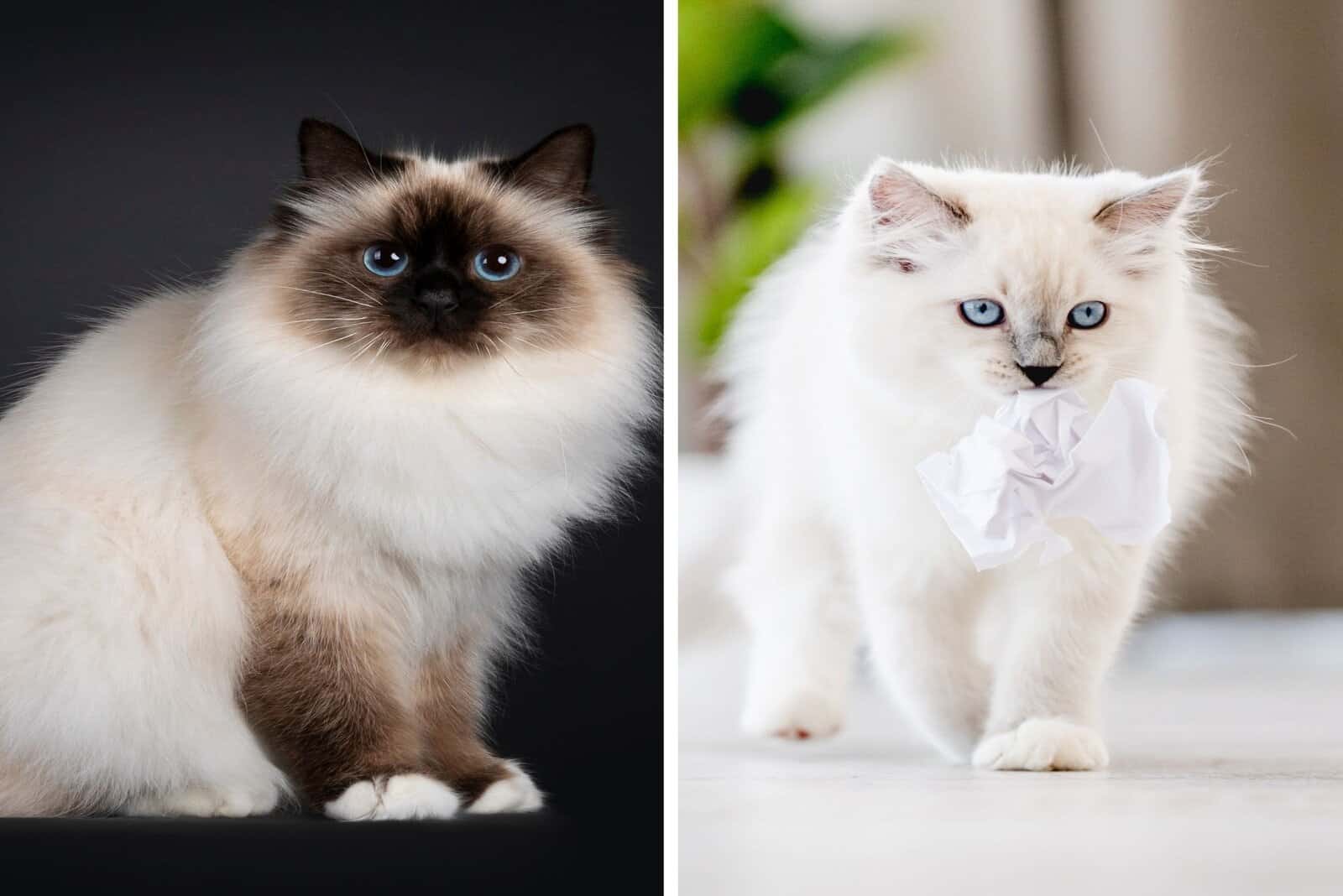
When it comes to personality, as you’ll see, they are very similar. Some traits they have in common are:
🐾 being affectionate
🐾 loving being held and cuddled
🐾 very loyal
🐾 relaxed and laid back
Both Birman and Ragdoll cats have very charming and loving personalities, although there are some differences.
Let’s go over some traits one by one!
1. Energy Levels
Birman
Birmans are not the most energetic cats, but they’re not the laziest either. They’re kind of in the middle, so their energy level is moderate. Their daily exercise needs are average, so you will not have to entertain your cat with toys 24/7, but do play occasionally. Once they get tired, you don’t have to worry they will “bounce back” immediately.
Ragdoll
Ragdolls are very laid-back and quiet. They are not very active – so if you’re looking for a high-energy cat, this is not the cat for you. Ragdolls are nothing like the athletic, high energy Bengal or Abyssinian cat.
This means that Ragdolls are a great option for senior owners or cat lovers that are also… low energy. It’s safe to say thatRagdoll cats are a little bit lazy.
2. Playfulness
Birman
Birmans are more energetic, and thus more playful than Ragdolls. They love playtime with their owners, other members of the household, or even other pets. Some even compare Birman cats to dogs, due to their love for fetching a ball and dragging toys around with them.
Don’t get me wrong – they will not be playful all the time, and they still like their rest.
Ragdoll
When it comes to playfulness, you’ll have a higher chance of playing with Ragdoll kittens or young cats than with full-grown adult Ragdolls. Adult Ragdolls don’t care as much about playing; they prefer to just chill out.
That doesn’t mean they don’t like a good play-session now and then! They can be trained to play fetch, and they love all kinds of toys – balls, scratching posts, and cat trees.
Ragdolls have a slight risk of gaining extra weight due to their “lack of energy”, so it’s important to incorporate playtime into your Ragdolls daily schedule.
3. Need For Attention & Clinginess
Birman
Birman cats love snuggles and attention, but not too much of it. They are nothing like the super-needy cat breeds (such as the Ragdoll), but they sure do love cuddling and socializing with people and other pets.
Ragdoll
When talking about clingy cat breeds, the Ragdoll takes one of the first 3 spots for sure. Just like their clingy-companions the Oriental Shorthair cat, Burmese, Persian, Siamese cat or the Sphynx, Ragdoll cats want and need your attention.
Ragdoll cats love to cuddle, meow, sleep on your lap, and follow you around. They don’t like being alone for long periods of time and will run towards the door as soon as they hear you come in. They are highly affectionate by nature, so keep in mind that these cats need a little bit more attention than some other cat breeds.
4. Friendliness
Both breeds of cat are very friendly towards people and other pets. This is due to their calm and laidback personalities, as well as their love of affection and attention. They are easy to handle, which makes them one of the most desirable cat breeds there is.
Birman and Ragdoll cats are both known to be very loyal and they quickly become their owner’s lifelong friend.
They each adapt easily to new environments, so new people or pets don’t create stress for them at all. They actually love being around people and pets (new or old – it doesn’t matter) and get along with them nicely. This high tolerance level comes in handy when it comes to playing with kids.
Ragdolls are so friendly that they often get compared to dogs and are commonly called “puppy cats”. How cute is that?
5. Aggression
Neither the Birman or the Ragdoll cat are aggressive by nature. In fact, they are the exact opposite of that; they’re very calm and tolerant.
One thing to note is that Birman cats can be a bit territorial, but not necessarily aggressive.
Of course, any cat can be aggressive due to poor socialization, lack of training, bad temper, and if they feel threatened.
Generally speaking, Birman and Ragdoll cats are not aggressive by nature.
General Information: Similarities & Differences
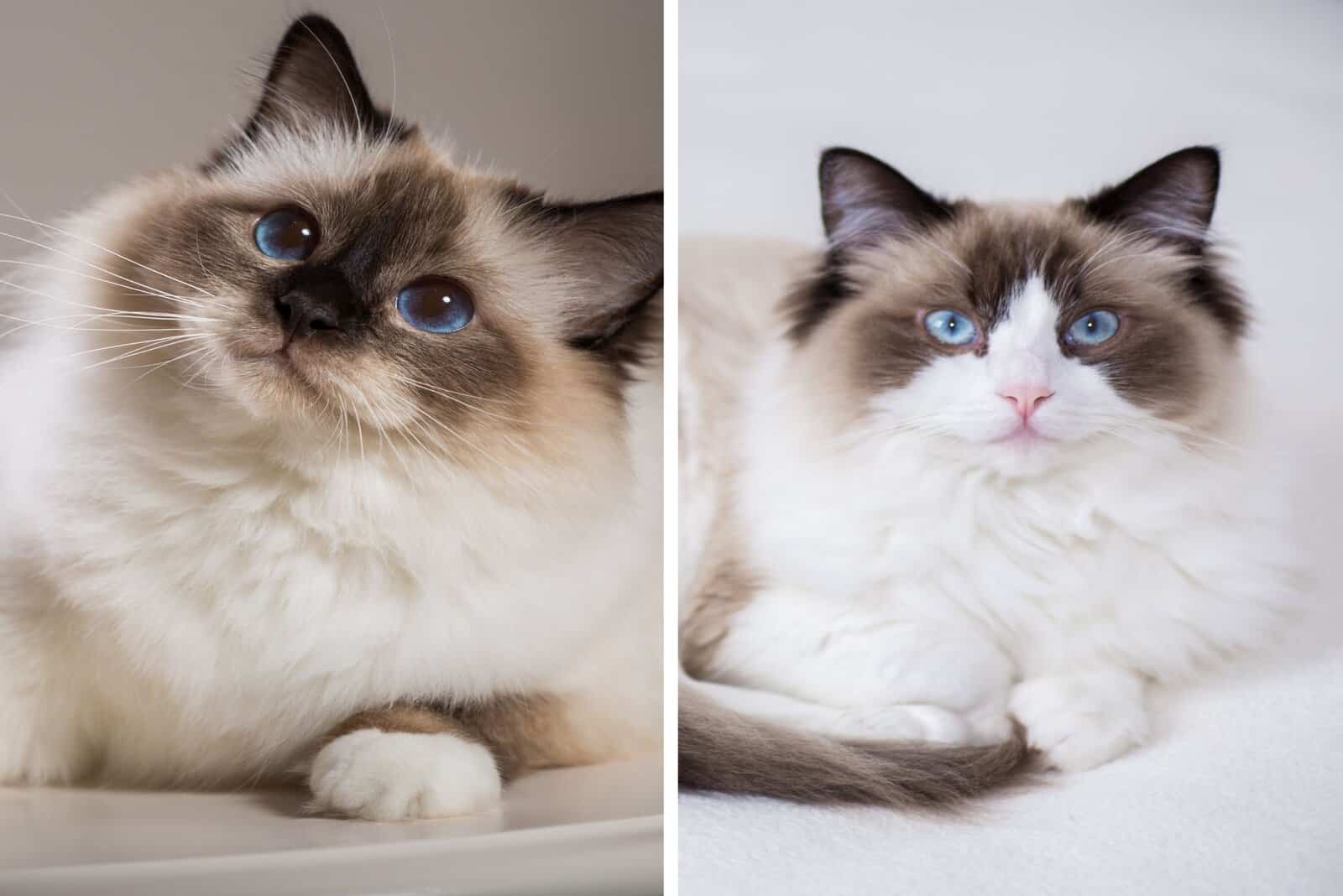
1. Ancestry
Ragdoll
In the early 1960s, a breeder named Ann Baker developed the Ragdoll cat breed. The creation of this cat breed is a bit of a mystery. There is a famous story that goes like this:
Ann Baker’s pure white longhaired cat (an Angora), Josephine, was injured by a car and sent to the hospital, where the government performed tests on Josephine. After that, Josephine’s subsequent litters were not quite like her “usual” litters – all new kittens were very laid-back, gentle and loving. Josephine kittens were then bred with cats whose traits Anne found desirable (such as the Persian cat), and the Ragdoll breed eventually arose.
So the reason why all Ragdolls today are highly affectionate and docile is all due to… government tests being performed on Josephine?! I don’t know how believable that is, but it sure makes for a very interesting story of how this breed was created!
Birman – The Sacred Cat Of Burma
The Birman cat is also called “The Sacred Cat of Burma”. Why is that? Well, the story goes like this:
The Birman cat breed was raised by priests in a temple in Burma (today’s Myanmar). As one master was dying, a white cat that was standing over him transformed into a cat with a dark head, legs and tail, while the coat became cream-colored with a golden glow. The story tells us that the glow came from the master. When the master died, his soul passed on to the cat. The cat’s paws became white because the cat was standing on the master’s chest. The white color represented the master’s purity. When the cat looked up, his eyes became blue, the same as the master’s.
There are numerous versions of this story, some are much longer. This is the most concise version I could write but I did enjoy reading about the mythical origin of the Birman!
Are There Official Records Of Birman’s Ancestry?
When it comes to oficial records, the origin of this breed is unknown. It is believed they originated in Burma as companions of temple priests, and some of them were taken to France. There, they reproduced and gave rise to the Birman cats we know today. The circumstances under which they were taken to France are unknown, but there is a lot of mystery and many stories about it.
Another fact is that Birmans were almost rooted out completely during World War II. There was only one Birman breeding couple left in France and all Birman cats today are their descendants.
2. Lifespan
Both cat breeds have pretty much the same lifespan. The average lifespan is anywhere from 9-15 years. Some cats can live much longer than this and there are records of members of both cat breeds living past the age of 22.
Of course, it all comes down to the individual cat’s genetics, diet, amount of physical exercise, etc.
3. Intelligence
Both Birman and Ragdoll cats are quite intelligent. They can be trained. For example, they can be taught to do some tricks such as “fetch”, ”come” and “roll over”.
4. Diet
They don’t need any special kind of diet. Like any other cat, they need lots of proteins, some fat, and a minimal amount of carbohydrates. Make sure they drink their water and don’t give them too many treats (but you already know this!)
One thing to keep in mind is that Ragdolls can get a bit chubby due to lack of activity. That’s why it’s important that they have a healthy diet and enough physical activity, so you can avoid weight gain.
5. Grooming Needs
The absence of undercoat for both breeds is a benefit for cat owners that don’t want a cat that sheds a lot or needs a lot of grooming.
The Ragdoll and Birman only need a little bit of grooming:
🐾 they need to be brushed and combed every week.
🐾 some minor tangles should be expected.
🐾 a metal comb is recommended.
They are semi-longhaired, so their shedding is not substantial.
6. Health Issues
Both cat breeds are relatively healthy, especially if they came from a good breeder. Their health is maintained by a good diet, physical exercise, and routine veterinary check ups.
Just as every cat, they do have a tendency to develop some health problems.
Birman
🐾 obesity
🐾 hypertrophic cardiomyopathy
🐾 kidney issues
Ragdoll
🐾 hypertrophic cardiomyopathy
🐾 urinary tract infection
🐾 gum disease
7. Price
The price of a kitten from either of the two breeds is in the same range. This can be anywhere from $400 up to more than $2500. It all depends on if you’re getting a cat just to be a pet, or if you want a show cat.
As you might expect, a cat show Ragdoll or Birman cat costs a lot more than a “regular, pet” Ragdoll or Birman kitty.
Ragdoll Vs Birman: A Summary
| Trait | Summary |
|---|---|
| Size | Ragdolls are bigger compared to ragdolls |
| Type of fur | Both have no undercoat and are semi-longhaired |
| Coat pattern | Birmans have one pattern - pointed, Ragdols have others as well |
| Coat color | Birmans are most commonly seal, Ragdolls - seal and blue |
| Facial features | Usual, no extreme traits |
| Eyes | Both have distinctive large, blue eyes |
| Energy level | Birmans are more active than Ragdolls |
| Playfulness | Both breeds are playful |
| Clinginess | Ragdolls are much more clingy |
| Friendliness | Both cat breeds are famous for being very friendly |
| Aggression | Neither cat breed is aggressive by nature |
| Ancestry | Ragdoll’s ancestry is known, Birman’s is not completely known |
| Lifespan | Average lifespan is 9-15 years for both |
| Intelligence | Both are very intelligent |
| Diet | They don’t have any special dietary requirements |
| Grooming Needs | Their fur is low maintenance |
| Health Issues | Both cat breeds are relatively healthy |
| Price | Anywhere from $400-$2500+ |
9 Quick FAQ
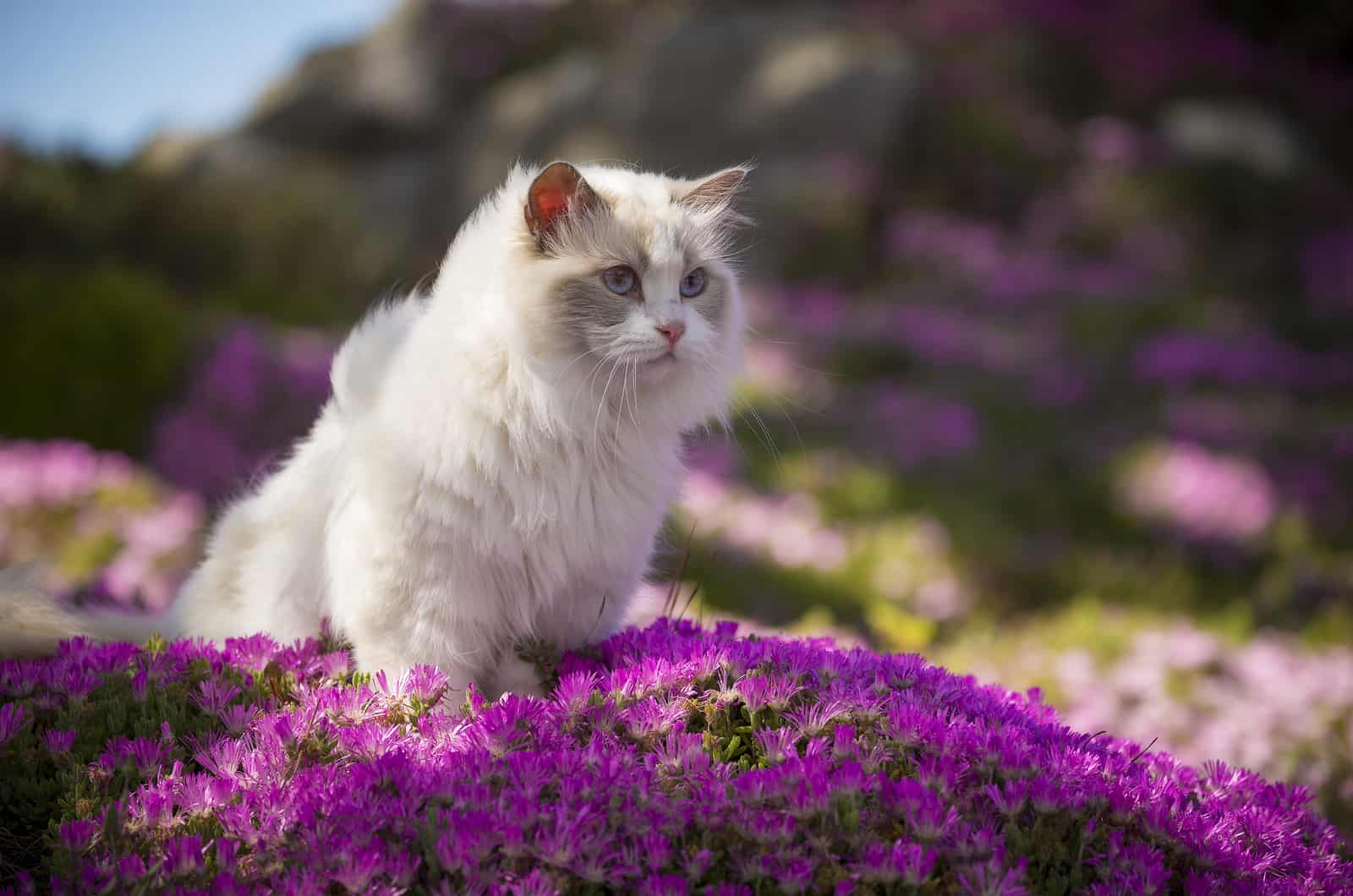
1. Which Is Better – Birman Or Ragdoll?
There is no answer to this question as it is not fair to compare these two breeds.
They’re both equally beautiful, intelligent, and loving; any owner would be lucky to have either of them as pets!
2. What Is The Difference Between Birman And Ragdoll?
Birman and Ragdoll cats have many similarities, but also some differences. For example;
🐾 Both can be colorpoint, but Ragdolls can have other coat patterns too, while Birmans don’t.
🐾 Birman cats are usually seal point, while Ragdolls are most commonly seal but also blue point cats.
🐾 The Birman has a dark-colored face, while Ragdolls usually have a white inverted V mark.
🐾 They can be similar in size, but Ragdolls are almost always larger.
🐾 They’re both very laid back and calm, but Birmans are a bit more active.
🐾 Both are very affectionate and loving, but Ragdolls are much more clingy.
3. Is A Ragdoll Bigger Than A Birman?
Yes, both male and female Ragdoll cats are bigger than male and female Birman cats. The Ragdoll weighs more and is taller; the difference is not enormous but it is noticeable.
4. Are Birmans Or Ragdolls More Affectionate?
Ragdolls are the kings and queens of showing affection. They are famous for being Gentle Giants.
Don’t get me wrong – Birmans love giving and receiving affection as well! But Ragdolls like it even more.
5. Which Is More Independent And Which Is More Interactive?
Neither breed are the most independent cats. They love (and need) companionship and socialization with humans or other pets. Ragdolls are more in need of attention, so Birmans are considered more independent.
Both cats are equally interactive. They are known to love playtime, socialization, and cuddles!
6. Do Birman Cats Need A Lot Of Attention?
Birman cats do need attention, but they don’t need attention 24/7. Even though they’re known to be affectionate and love attention, they also like their alone time as well.
7. Are Birman Cats Good Indoor Cats?
Yes, Birman cats are very good indoor cats and in fact, they are usually kept as indoor cats. This is not to say they cannot step foot outside the home, but they should not be kept outside.
8. Are Birman Cats Cuddly?
Yes, Birman cats are cuddly! They are known to be very affectionate and loving. They will never say No to a quick nap on your lap or a little bit of cuddling.
9. How Much Does A Birman Cat Cost?
A Birman cat can cost anywhere from $300 to more than $2500. Cat show standard Birman cats are, as expected, on the pricier side.
Final Thoughts
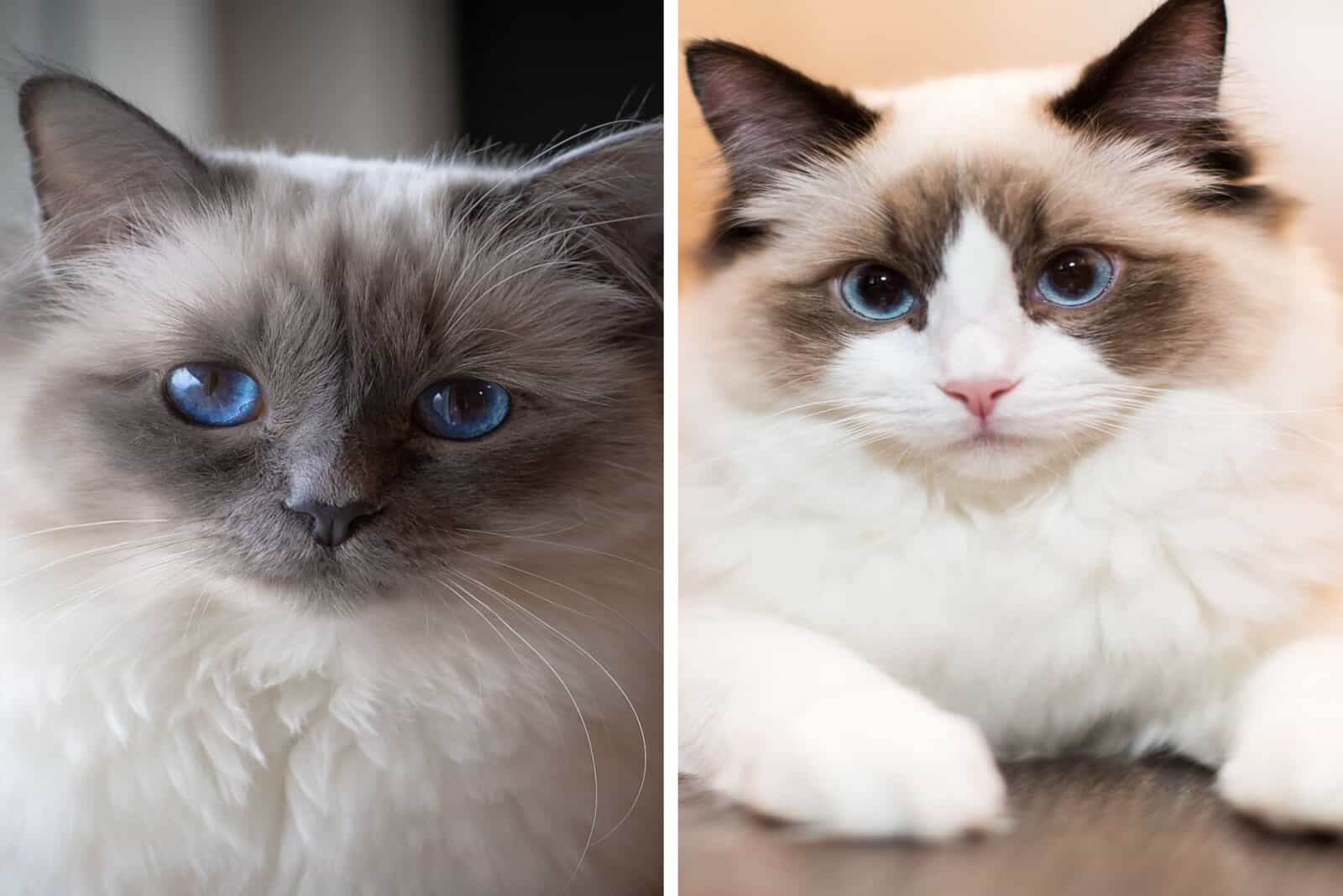
If you’re having trouble differentiating Birman vs Ragdoll, I completely understand… I have been around cats all my life, and I’ve seen a decent number of Birman And Ragdoll cats, but even now, if you put one of the two in front of me – I might not be able to tell if it’s a Birman or a Ragdoll straight away.
After remembering the differences, (Ragdolls being bigger, Birmans having a fully colored face, Ragdolls usually having a white inverted V mark on their face) I would hopefully be able to tell you the correct answer.
They are also different in their energy levels (Ragdolls are a bit lazy), playfulness (Birmans love playtime more) and clinginess (Ragdolls are more clingy).
But in general, they have a lot of things in common – their distinctive blue eyes, similar coat pattern and color, and both being affectionate, social and loving.
I hope you’ve enjoyed reading this article and that you’ll be able to differentiate between Birman cat vs Ragdoll if you ever get put to the test!
Related Articles:
Himalayan VS Ragdoll Cat: Breed Comparison




